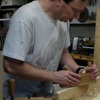
Originally Posted by
David Keller NC

You can also do the same with chlorox, but the same precautions apply. A snootful of fumes from a concentrated chlorix solution will be just as damaging as a snootful of ammonia vapors.
And as long as we're talking about these chemicals, absolutely DO NOT mix them. I don't know the precise chemical reactions, but chlorine bleach mixed with ammonia (either plain old household strength or more powerful industrial strength) produces toxic chloramine gas. Bleach mixed with acids releases chlorine gas. You may remember these as some of the gases used in chemical warfare during World War I.
Here's a fact sheet on the dangers of mixing household cleaning chemicals: http://www.state.nj.us/health/eoh/cehsweb/bleach_fs.pdf
Steve, mostly hand tools. Click on my name above and click on "Visit Homepage" to see my woodworking blog.





 Reply With Quote
Reply With Quote





